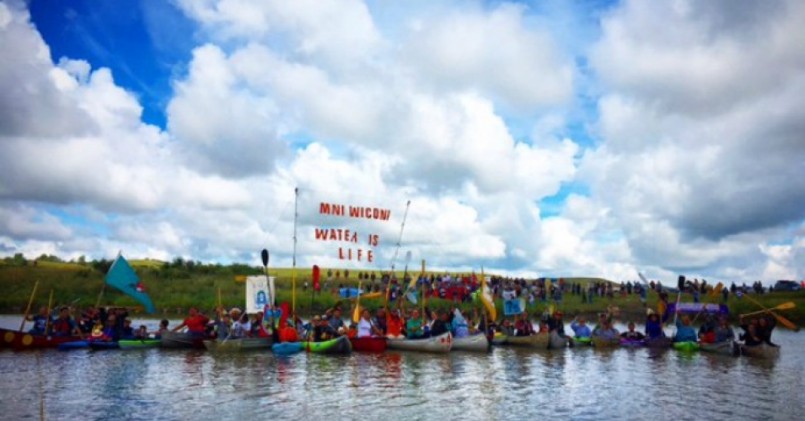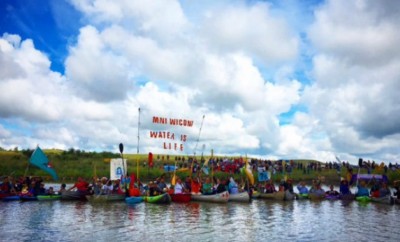Environment
The Standing Rock Sioux pipeline standoff

Image: CommonDreams
The months-long standoff over the Dakota Access Pipeline continues at the Standing Rock Sioux reservation of North Dakota, drawing together the largest unification of Native Americans in more than 100 years. Indigenous groups of over 100 different tribes from all over the country and Canada have been living in camps near the Cannonball River, many as whole families, on the reservation to help monitor and protest the construction of the four state, multi-million dollar oil pipeline. If the pipeline were to be completed, it would carry approximately 500,000 barrels of crude oil daily through the North Dakota Bakken oil field to Illinois, and then connect up with another existing pipeline which would continue to carry the oil the rest of the way to Texas. As dramatic events have taken shape in recent days, protesters from multiple tribes have clashed with a private security crew hired by the construction firm Energy Transfer Partners’ Dakota Access LLC and their attack dogs, resulting in several protesters being bitten as well as pepper-sprayed by security staff. The most heated part of the clash seems to have arisen after the bulldozing of ancestral burial grounds and other possible cultural sites started over the weekend. Injuries were reported on both sides of the incident to both humans and dogs.
At the time of this writing, most recent reports indicate the U.S. Army Corps of Engineers has agreed to a temporary halt on the pipeline’s construction, which was demanded in an emergency hearing in Washington D.C. today. The halt, allowed for only part of the land in question by U.S. James Boasberg, will continue while both sides await a judicial court’s final decision on September 9 regarding the legality of proceeding with the pipeline. The U.S. Army Corps of Engineers stated they felt “the public interest would be served by preserving peace” until the judge issues a ruling.
The tribes are concerned with not only possible water pollution from the pipeline, but the destruction of areas holding “significant cultural and historic value” to their ancestors and themselves. The Native Americans state they are taking a stand for future generations, protesting and pressing for the consideration of whether the necessary tribal consultation was followed regarding the National Historic Preservation Act ahead of the construction. The burial grounds, according to Dakota Access, were untouched by their bulldozers and construction was taking place on the company’s construction schedule without destroying any important historical sites. Dakota Access claims it will “create thousands of jobs and generate more than $40 million in tax revenue for the state of North Dakota.”
One of the large camps of protesters, Red Warrior Camp, is maintained by various tribes including some members of the Sioux. A camp protester interviewed by BBC recently explained that, “This is about water. Water is the life of our people. Without it, we cannot exist.” Another camper interviewed shared the perspective that some protesters believe the current Dakota Access standoff is the “last Great Indian War,” explaining that “This is the first time the seven bands of the Sioux have come together since Little Bighorn (the battle during which invading cavalry commander General Custer was killed),” he said. “Now, we have no weapons, only prayers. We are here for what our ancestors fought and died for. We have endured 250 years of betrayal by the white man.” Nearby Sacred Stone Camp, taken from the Indian name Inyan Wakangapi Wakpa, which was once given for the sandstone formations previously created by the whirlpool that existed where the Cannonball River meets the Missouri River, is also comprised of numerous campers of various tribes and protesters. According to LaDonna Bravebull Allard, Founder and Director of the Sacred Stone Camp, “The sacred stones are not created anymore, ever since the U.S. Army Corps of Engineers “dredged the mouth of the Cannonball River and flooded the area in the late 1950s as they finished the Oahe dam. They killed part of our river.”
Daily demonstrations by the campers normally occur along the road leading out of the Dakota Access construction site with protesters waving tribal flags and possibly obstructing traffic or pipeline progress. More than twenty Native American protesters have been arrested in August alone including David Archambault II, the Standing Rock Sioux tribe chairman. Archambault stated in regard to the recent bulldozing, “This demolition is devastating. These grounds are the resting places of our ancestors. The ancient cairns and stone prayer rings there cannot be replaced. In one day, our sacred land has been turned into hollow ground.”
LaDonna Bravebull Allard insists the issue goes even deeper for her, “We must remember we are part of a larger story. We are still here. We are still fighting for our lives, 153 years after my great-great-grandmother Mary watched as our people were senselessly murdered. We should not have to fight so hard to survive on our own lands. My father is buried at the top of the hill, overlooking our camp on the riverbank below. My son is buried there, too. Two years ago, when Dakota Access first came, I looked at the pipeline map and knew that my entire world was in danger. If we allow this pipeline, we will lose everything. We are the river, and the river is us. We have no choice but to stand up.”





0 comments